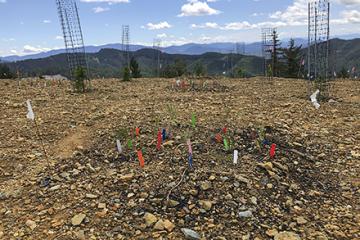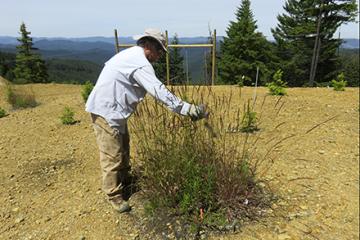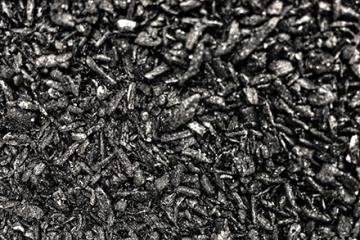Exploring the Benefits of Biochar
Centuries ago, ancient Amazonians disposed of their agricultural waste by burying and burning it. As their discarded crop husks and scraps smoldered beneath layers of soil, the area around the burn site became especially fertile and productive.
Today, we recognize that this ancient practice holds modern promise.
Burning biomass in low-oxygen conditions creates biochar, a carbon-rich substance that some experts tout as the key to soil rejuvenation. Relatively light-weight and porous, biochar can act like a sponge and serve as a habitat for many beneficial soil microorganisms that are known to promote soil and plant health.

Experimental plots a few weeks after herbaceous plants were transplanted into biochar-amended plots at the Formosa mine (Riddle, OR). (Kristin Trippe, D4583-1)
Agricultural Research Service (ARS) research microbiologist Kristin Trippe and her team study the effects of biochar on poor-quality or significantly degraded land. This includes abandoned mining sites, where severe pollutants like heavy metals have infiltrated the soil and made it impossible or difficult for natural vegetation to grow. With soil pH levels lower than 0 at some sites, the earth is still barren even after decades. For reference, most plants grow best in soil with a pH range of 5.5 to 7.0; outside of that range, plants are less able to absorb necessary nutrients.
“In our research, we’ve found that biochar is most effective when applied to marginal soils with high acidity levels – exactly the kind of soil that abandoned mines tend to have,” Trippe said. “Biochar amendments not only elevate pH but also mitigate some of the heavy metal toxicity in soil, increasing plant growth in places that couldn’t necessarily support it before.”
The good news doesn’t just stop there. Farmers might find biochar useful not only as a substitute for chemical fertilizers, but also as a way to efficiently deal with agricultural waste. For example, farmers can process excess chicken litter into biochar, taking advantage of the plentiful nutrients in the manure while eliminating waste. Biochar can also be created from wood chips, corn stalks, and weeds.

Dr. Mark Johnson (US EPA, Corvallis, OR) examines the herbaceous plants in the biochar amended plots 1-year post-planting. (Mark G. Johnson, EPA, D4584-1)
“Not all biochar is the same. It’s really tunable,” explained Trippe. “The raw material base used and the temperature that the material was heated to changes the chemical composition of biochar. The impacts of biochar depend on variables like these, so users can customize it to better match the soil’s needs.”
Currently, the creation and application of biochar is still a bit too pricey to replicate on a massive, industrial scale for most. Obtaining the right type and amount of biomass, burning it properly, and applying it over acres of land may be difficult, time-consuming, and financially straining. However, home gardeners may explore the potential benefits of biochar by visiting their local home improvement stores or creating their own from lawn clippings or organic scraps.
The global biochar market was worth approximately $1.3 billion in 2018, with expectations that it will triple in value by 2025. – by Georgia Jiang, ARS Office of Communications.


